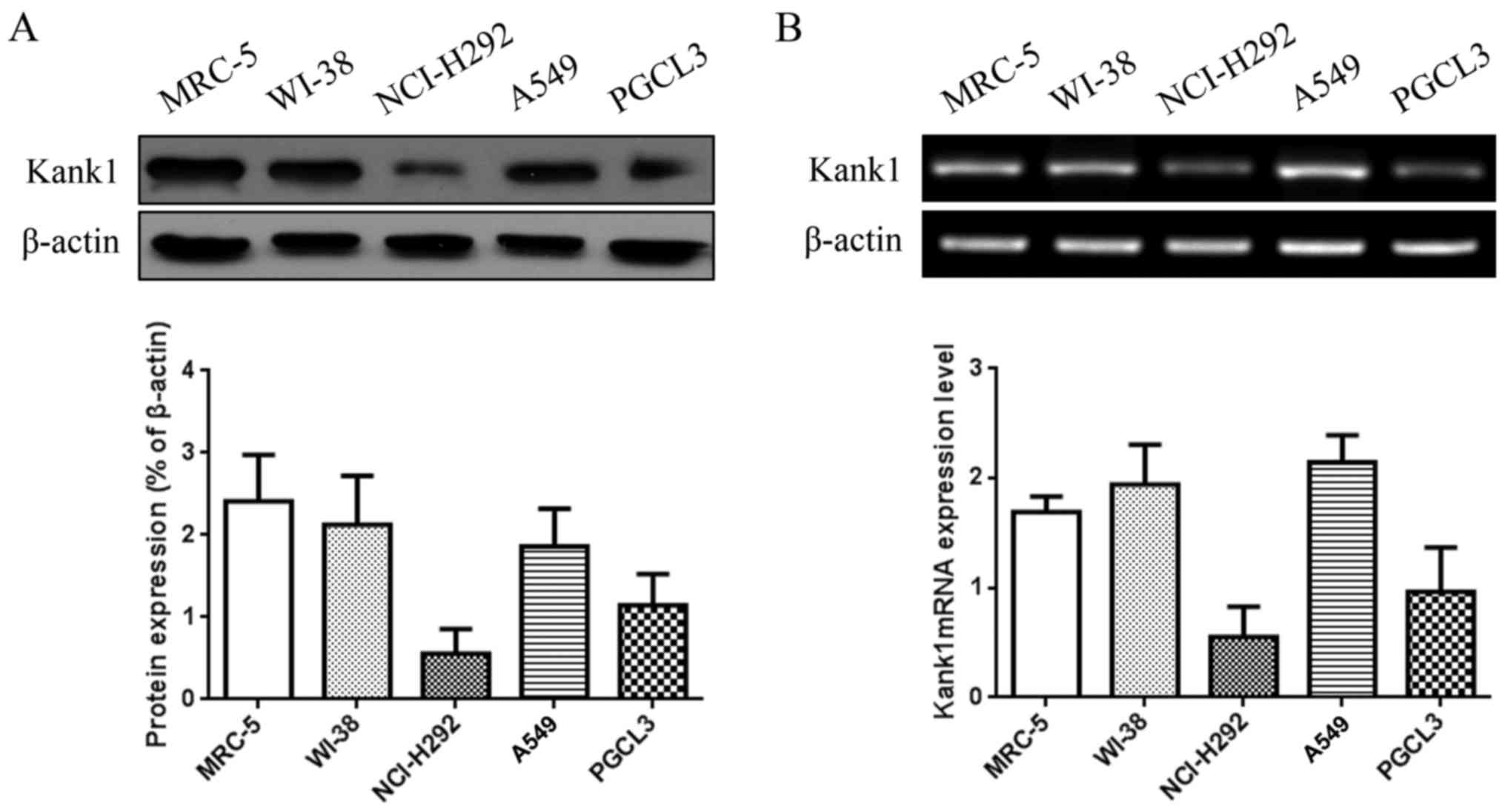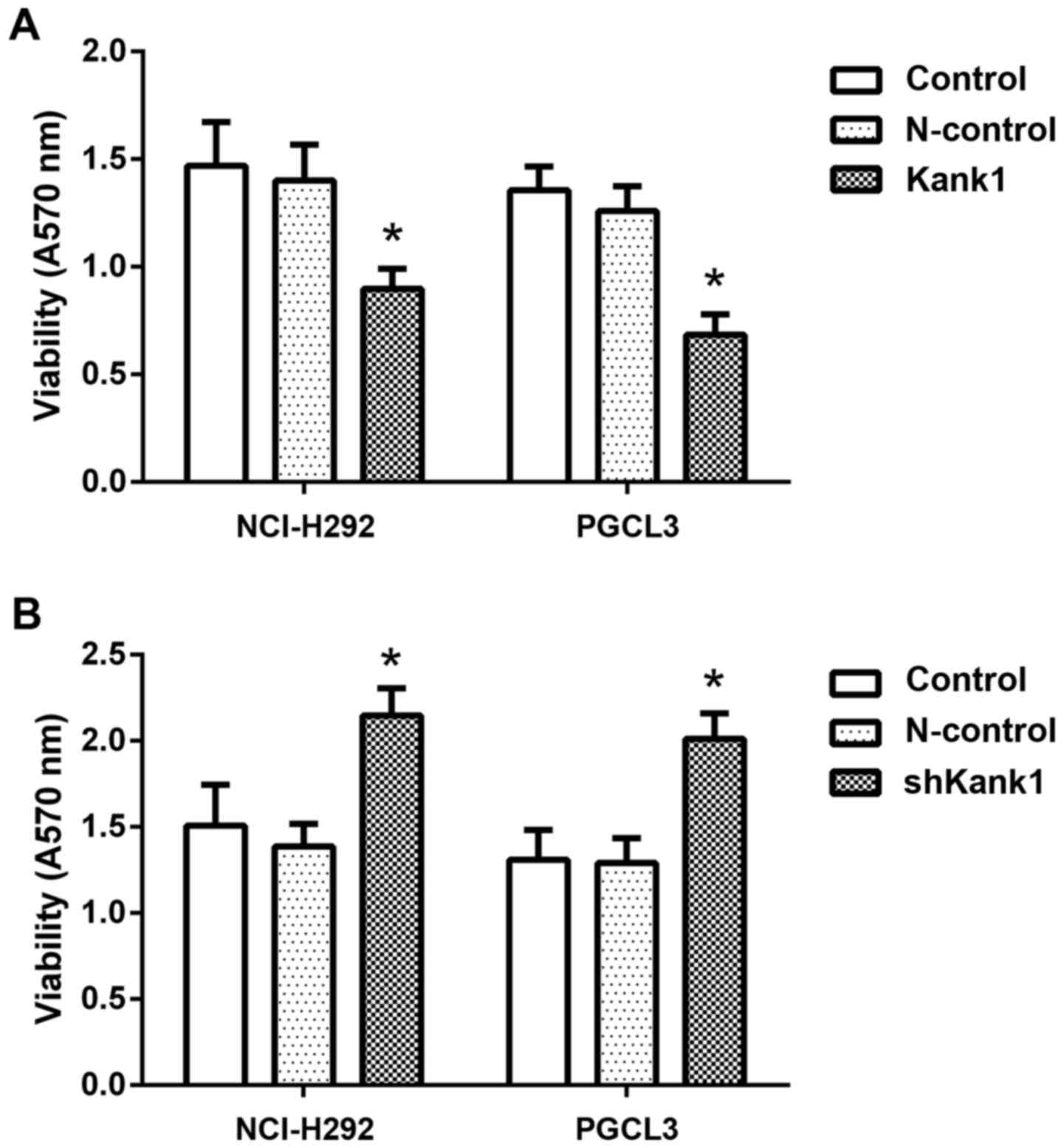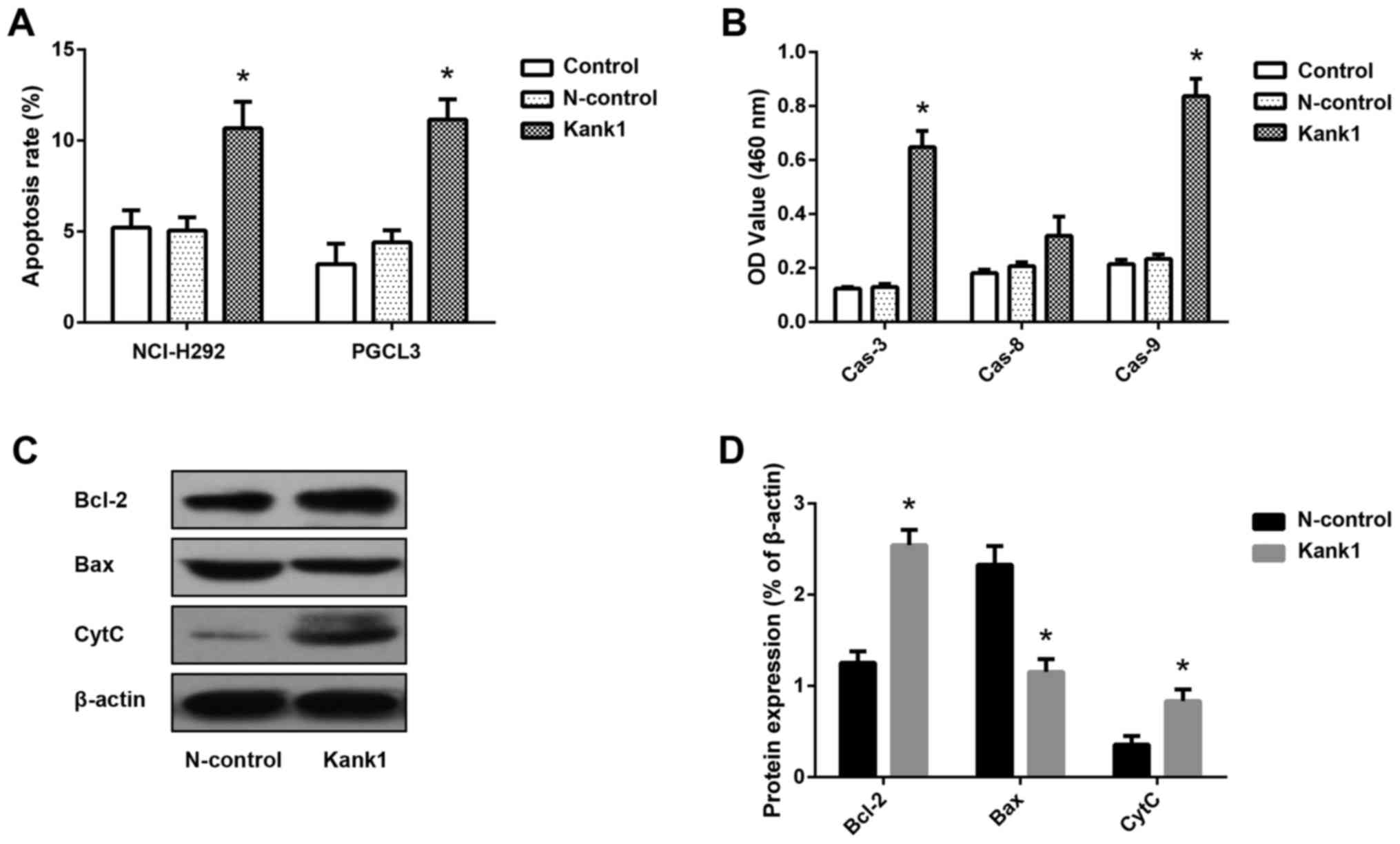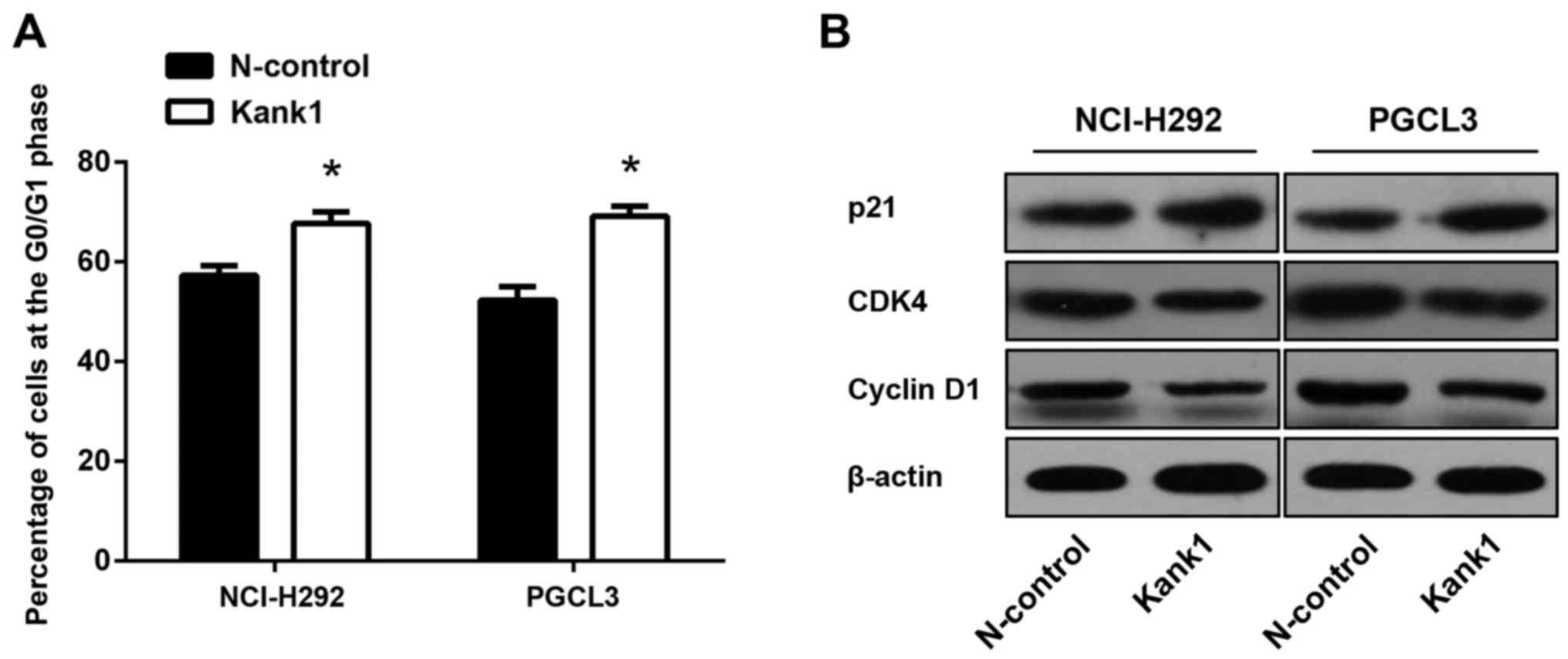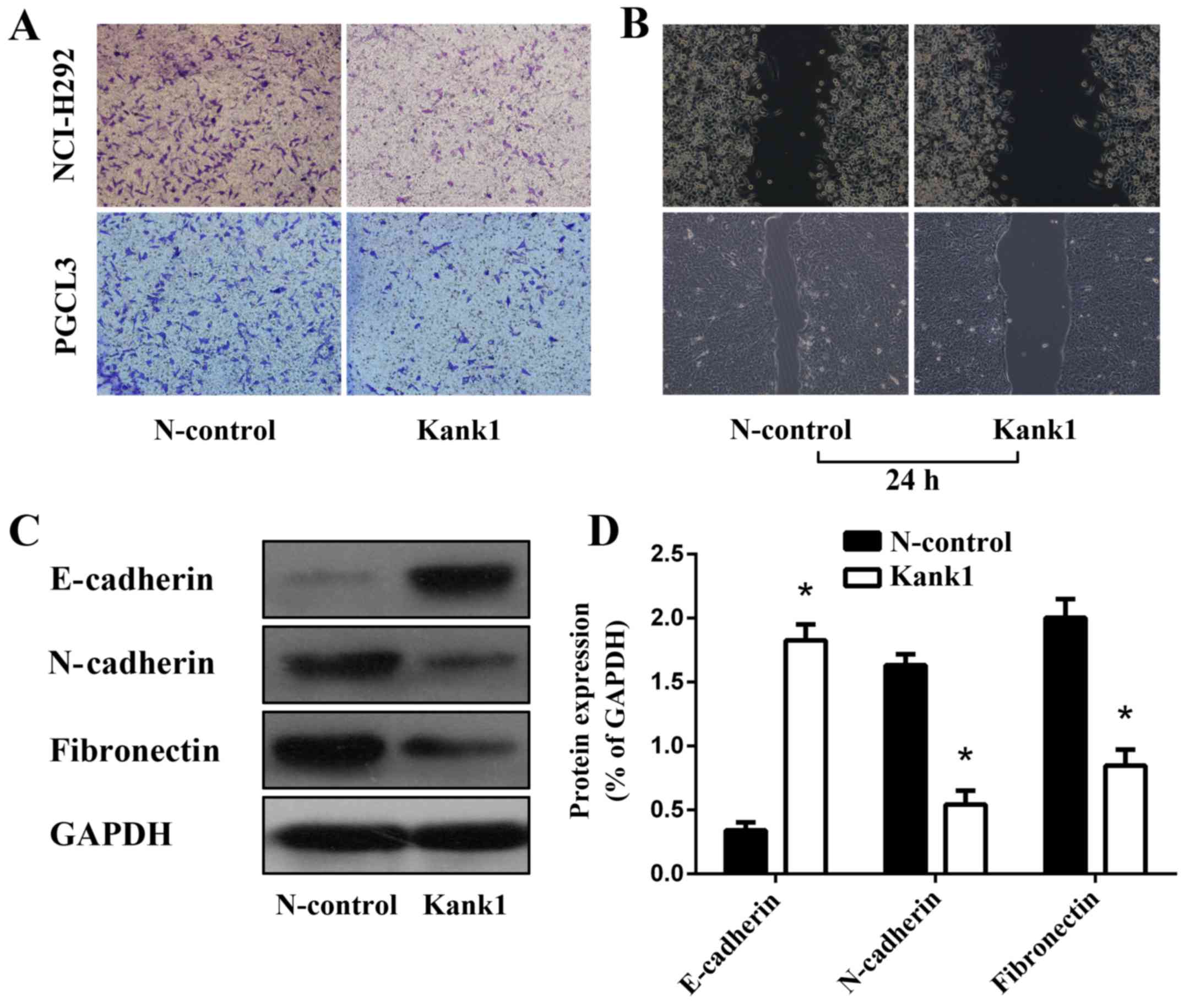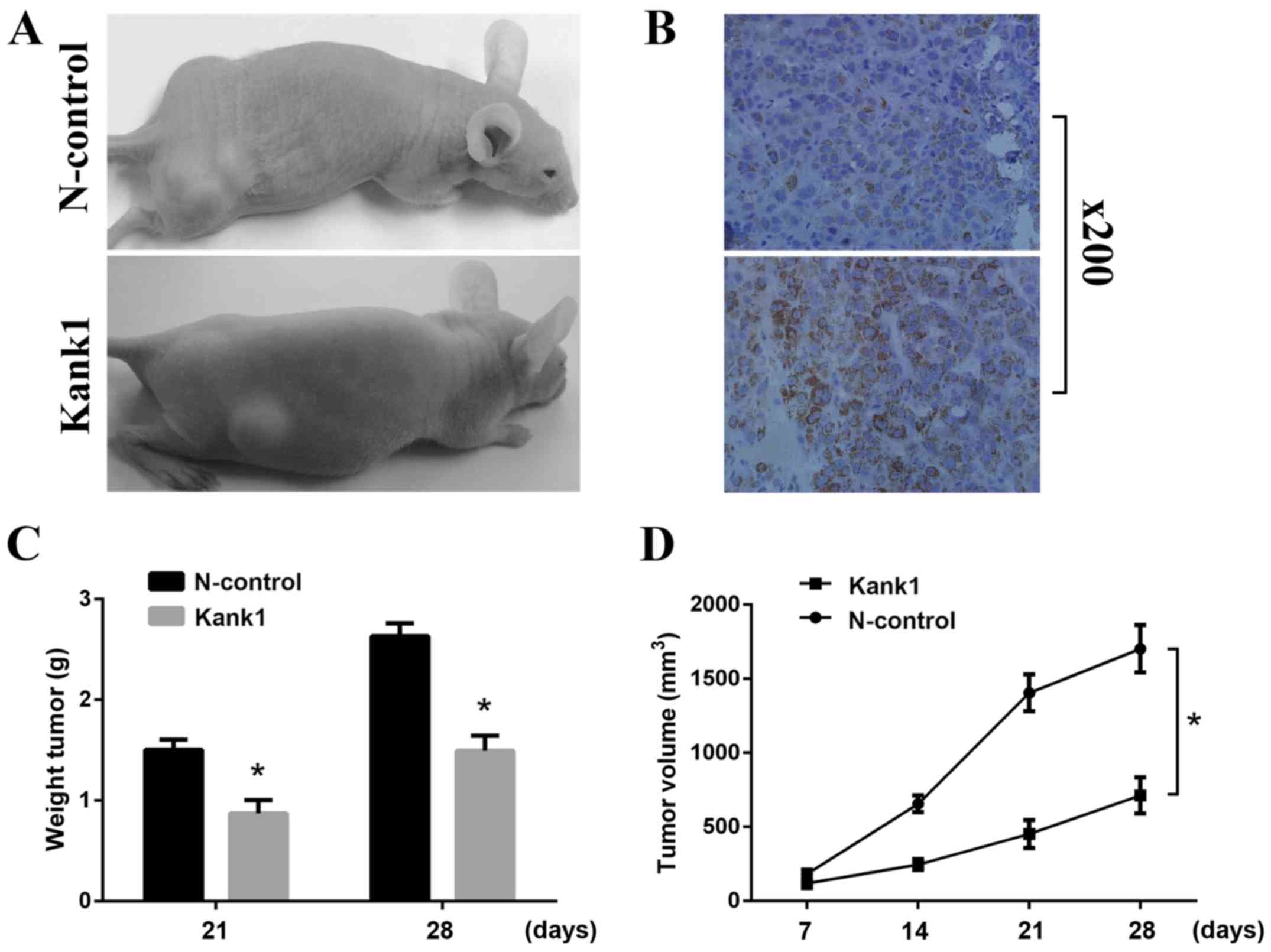Upregulation of the Kank1 gene inhibits human lung cancer progression in vitro and in vivo
- Authors:
- Published online on: June 26, 2018 https://doi.org/10.3892/or.2018.6526
- Pages: 1243-1250
Abstract
Introduction
Lung cancer is the leading cause of cancer-related deaths, particularly in underdeveloped countries since it produces the highest percentage of deaths than any other cancer (1). The tendency of metastasis is very high in the late stage of lung cancer, and the clinical treatment of lung cancer is mainly radiotherapy and chemotherapy. However, the results are often unsatisfactory due to the short survival time of patients and the tendency of recurrence which is high. In recent years, there has been more and more research conducted on molecular targeted therapy of lung cancer, and it is increasingly important to explore the molecular mechanisms of lung cancer development (2,3).
The specific mechanism of tumor genesis and development is complex and changeable. The deletion or mutation of a tumor-suppressor gene and the expression of a large number of oncogenes have important impacts on tumorigenesis. In 2002, Japanese scholars cloned a candidate tumor-suppressor gene, the Kank1 gene in renal cell carcinoma using heterozygous deletion analysis (4). The Kank family is mainly composed of 4 genes, Kank1-Kank4, of which Kankl plays a certain role in the inhibition of tumorigenesis and development (5). The present study revealed that Kankl exhibited a low expression in various tumor tissues including kidney (6), liver (7,8) and lung cancer (9,10). Kankl is mainly distributed in normal tissues, including renal tubular epithelial cells and the glandular cells of other digestive organs. Its main function is the polymerization with actin of the cytoplasm adjusting the cytoskeleton, and driving cell motility (11). In addition, it can form a complex with β-catenin shuttling it in the nucleus to regulate β-catenin subcellular distribution. Studies have revealed that downregulation of the Kankl gene participates in the genesis and development of bone tumors by activating the JAK2/Stat tumor-promoting signaling pathway (12).
In the present study, we found that the expression of the Kankl gene was low in lung cancer tissues and lung cancer cells. Following upregulation of the Kankl gene, tumor cell proliferation was significantly inhibited, and apoptosis occurred. Concurrently, the expression of Bax decreased and the expression of Bcl-2 increased, while the expression of the caspase family was also altered, mainly with the activation of caspase-3 and −9. In addition, upregulation of the Kankl gene also reduced the invasion and metastasis of tumor cells. In an in vivo experiment, we found that the implantation of upregulated Kank1 lung cancer cells into nude mice resulted in lower tumorigenicity and the significant decrease of tumor volume in nude mice. In summary, we concluded that upregulation of the Kankl gene inhibited the progression of lung cancer both in vitro and in vivo, and its mechanism was closely related to cell apoptosis and tumor invasion and metastasis.
Materials and methods
Cell lines and culture
Human lung cancer cell lines NCI-H292, A549 and PGCL3 cells, and normal human lung cell lines MRC-5 and WI-38 were purchased from the American Type Culture Collection (ATCC; Manassas, VA, USA). The aforementioned 5 cell lines were all cultured in RPMI-1640 medium containing 10% fetal bovine serum (FBS) in an incubator at 37°C, with 5% CO2 and saturated humidity. RPMI-1640 medium and FBS were purchased from Gibco; Thermo Fisher Scientific, Inc. (Waltham, MA, USA).
Antibodies and reagents
Kank1 (dilution 1:2,000; cat. no. AM8596b) was purchased from Abgent, Inc. (San Diego, CA, USA). Bax (dilution 1:1,000; cat. no. 2772T), Bcl-2 (dilution 1:1,000; cat. no. 2872T), caspase-3 (dilution 1:1,000; cat. no. 9662S), caspase-9 (dilution 1:1,000; cat. no. 9502T), MMP-7 (dilution 1:1,000; cat. no. 71031S) and MMP-9 (dilution 1:1,000; cat. no. 3852S) antibodies were purchased from Cell Signaling Technology, Inc. (Danvers, MA, USA). siRNA and plasmids were synthesized by Shanghai GenePharma Co., Ltd. (Shanghai, China). An RT-PCR kit was obtained from Takara Bio, Inc. (Otsu, Japan). PI was purchased from Sigma-Aldrich (St. Louis, MO, USA). An Annexin V-FITC apoptosis assay kit was purchased from BD Biosciences (San Jose, CA, USA).
Cell transfection
Human lung cancer cells in the logarithmic growth phase were collected and cultured in 6-well plates at a density of 6×105 cells/ml. Negative oligonucleotides were used as a control. The medium was replaced with serum-free and antibiotic-based medium, according to the procedure on the transfection of reagents. Following the transfection of siRNA, the culture plates were placed in a CO2 incubator for 4–6 h, the medium was then replaced with the serum-containing medium and cells continued to culture. The transfected cells were screened after transfection with plasmids. After 3 weeks of selection, monoclonal antibodies (KANK1 antibody; dilution 1:2,000; cat. no. AM8596b) were purchased from (Abgent, Inc.) and chosen to expand the culture to establish an overexpressed Kankl human lung cancer cell line. Subsequently, the cells underwent RT-PCR detection.
RNA extraction and RT-PCR detection
Human lung cancer cells were divided into untransfected, blank plasmid pCMV-vec and the experimental group pCMV-Kank1. Total RNA was collected and extracted from each group of cells to assess purity and integrity before reverse transcription. Following calculation of the RNA concentration, the RT-PCR reaction was performed using an RT-PCR kit (Takara Bio), and the procedure was performed according to the manufacturer's instructions. Kank1 and β-actin gene primers were designed and synthesized by Invitrogen; Thermo Fisher Scientific, Inc. The primers were as follows: Kank1 gene upstream primer, 5′-CTTGACACAGTATTTTCACGCTTTTG-3′ and downstream primer, 5′-AAGTAAATGTGACACGGTAAAAAGG-3′; β-actin gene upstream primer, 5′-CTGGGACGACATGGAGAAAA-3′ and downstream primer, 5′-AAGGAAGGCTGGAAGAGTGC-3′. The PCR reaction system was 25 µl and the reaction conditions were as follows: 94°C for 2 min, denaturation at 94°C for 30 sec, annealing at 60°C for 30 sec, and extension at 72°C for 30 sec, for a total of 31 cycles. The resulting PCR product was electrophoresed on a 1.5% agarose gel and scanned using a Gel Doc™ XR+ Gel Documentation System (Bio-Rad Laboratories, Inc., Hercules, CA, USA).
Cell viability detection
Trypsin was used for the digestion and collection of the untransfected group, the blank plasmid pCMV-vec group and the experimental pCMV-Kank1 cell group, and then the cells were inoculated in 96-well plates, with each set consisting of 5 complex wells. The transfected group was replaced with complete culture solution after 24 h, and after 48 h, 20 µl of MTT solution (0.5 mg/ml)/well was added and incubated at 37°C for 4 h. The supernatant was removed and 150 µl of dimethyl sulphoxide (DMSO) was added to each well and shaken for 10 min until the purple crystals were completely dissolved. A microplate reader was used to detect the optical density of each well at 490 nm, and the average value of each group was calculated. The cell growth inhibition rate (%) = (1 - average A value of the treated group/average A value of the blank group) × 100%. The experiment was repeated 3 times.
Caspase activity assay
Caspase-3 and −9 activities were determined using the Caspase activity assay kit (Beyotime Institute of Biotechnology, Shanghai, China) according to the manufacturer's instructions after transfected human lung cancer cells, untransfected human lung cancer cells and blank plasmid transfected cells were collected. The assessment was performed with a fluorescence spectrophotometer at an excitation wavelength of 400 nm and an onset wavelength of 505 nm.
Flow cytometric analysis detects apoptosis and the cell cycle
The transfected human lung cancer cells and untransfected human lung cancer cells as well as the blank plasmid transfected cells were digested with 0.25% trypsin-EDTA and collected, then suspended in phosphate-buffered saline (PBS), and single cell suspensions were prepared. Flow cytometry (BD Biosciences) was used to detect apoptosis following the Annexin V-FITC apoptosis assay kit manufacturer's instructions. In addition, the cells were fixed with 70% ethanol overnight at 4°C. The cells were then washed with PBS 2 times, add 1 ml of propidium iodide (PI) comprehensive dye solution (containing RNase 10 µg, Triton X-100 5 µl), was added to stain the cells in the dark at 4°C for 30 min in order to assess the cell cycle. The stained cells were analyzed using a FACSCalibur flow cytometer (Becton-Dickinson; BD Biosciences).
Assessment of cell invasion and migration abilities
Each group of cells was cultured in BD 6-well Transwell culture plates (BD Biosciences). The cells were scratched using a standard 200 µl pipette tip, and were removed by washing with serum-free medium. Serial images were obtained at different time-points using a phase contrast microscope. The cell invasion assay was performed using Matrigel-coated Transwell chambers. The 8-µm filter in the upper chamber was covered with Matrigel diluted at 1:6, and each well was seeded with ~2×106 cells. After 36 h of culturing, the cells that reached the bottom of the culture well through the membrane were fixed with formalin and stained with crystal violet. Cells were randomly counted in 10 fields of view (magnification, ×200)/well (Olympus Corp., Tokyo, Japan).
Western blot analysis
Human lung cancer cells and their stably transfected cells were harvested and washed twice with PBS and 1 ml of protein lysis buffer (Sigma-Aldrich) containing 10 µl of protease inhibitor was added for cell lysis. The protein concentration was determined using bicinchoninic acid assay (BCA) method. The same amount of protein was added to each well for loading. The gel was separated on a 10% sodium dodecyl sulfate polyacrylamide gel electrophoresis (SDS-PAGE) gel. The protein was then transferred to a polyvinylidene fluoride (PVDF) membrane using a semi-dry method and blocked with 5% non-fat dry milk overnight at 4°C. Subsequently, it was diluted with Tris-buffered saline containing Tween-20 (TBST) solution and a primary antibody was added at 37°C for 1 h. The primary antibody dilution ratio (phospho-PI3K antibody, dilution 1:500; cat. no. 4228S; phospho-Akt antibody, dilution 1:1,000; cat. no. AP3434a; and MMP-7 antibody, dilution 1:800; 71031S; all were purchased from Cell Signaling Technology, Inc.). The membrane was washed 3 times with TBST. The secondary antibody anti-rabbit IgG, HRP-linked antibody (cat. no. 7074P2; Cell Signaling Technology) was added for incubation at 37°C for 1 h, and the membrane was then washed with TBST solution 4 times by shaking. An ECL luminescence reagent was added, X-ray exposure imaging was performed, the bands were scanned, and the grayscale analysis was performed. β-actin was used as a reference standard.
Nude mice inoculation
The animal experiment program was approved by the Medical Ethics Committee of Jiangsu College of Nursing. Twenty nude male mice, 6–8 weeks old and weighing ~20 g, were purchased from the Animal Experiment Center of Nanjing University. Housing conditions were controlled for temperature (18–22°C) and relative humidity (50–60%) on a light/dark cycle 10 to 14 h. Access to food and water was ad libitum. Nude mice were randomly divided into 2 groups and each group consisted of 10 mice. The constructed PGCL3 cell line and the blank plasmid pCMV-vec cell line with stably expressed Kank1 gene transfection were implanted into the subcutaneous right forelimbs of the 2 groups of nude mice, respectively, to observe the effect of Kank1 on the tumorigenicity of the transplanted tumors of the nude mice. The growth of the tumor was observed and assessed at 7, 14, 21 and 28 days. After 4 weeks, the nude mice were sacrificed by cervical spine dislocation, and the subcutaneously transplanted tumor tissue was excised under aseptic conditions for index analysis.
Statistical analysis
All experimental data were analyzed using SPSS 18.0 statistical software (SPSS, Inc., Chicago, IL, USA). A t-test and analysis of variance were used by ANOVA followed by Fishers' least significant difference. P<0.05 was considered to indicate a statistically significant result.
Results
The Kank1 gene is downregulated in human lung cancer cells
We detected the expression of Kank1 protein and mRNA in human lung cancer cell lines NCI-H292, A549 and PGCL3 and human normal lung cell lines MRC-5 and WI-38 by western blotting and RT-PCR. The results revealed that Kank1 protein and mRNA expression levels were significantly decreased in NCI-H292 and PGCL3 cells compared to the normal human lung cell lines (Fig. 1).
Upregulation of the Kank1 gene inhibits human lung cancer cell growth
To further confirm the effect of the Kank1 gene on the growth of human lung cancer cells, we successfully constructed and transfected Kank1 plasmid to upregulate the expression level of the Kank1 gene in human lung cancer cells. Concurrently, we downregulated the expression of the Kank1 gene in human lung cancer cells by shRNA and used MTT for analysis. We found that the proliferation of NCI-H292 and PGCL3 cells was significantly decreased after upregulation of Kank1 gene expression compared with the control group and negative control oligonucleotide-transfection group. In contrast, the proliferation of NCI-H292 and PGCL3 cells was increased upon downregulation of Kank1 gene expression. Therefore, it was demonstrated that the Kank1 gene had the ability to regulate the proliferation of human lung cancer cells (Fig. 2).
Upregulation of the Kank1 gene induces apoptosis in human lung cancer cells
To investigate whether the Kank1 gene is associated with apoptosis in human lung cancer cells, we upregulated the expression of the Kank1 gene and detected the apoptosis rate by Annexin V-FITC/PI double-labeling method. We found that the apoptosis rate of NCI-H292 and PGCL3 cells was significantly increased after upregulation of Kank1 gene expression compared with the N-control group (Fig. 3A). Concurrently, the activity of caspase-3 and −9 increased after upregulation of Kank1 gene expression. However, the activity of caspase-8 was not significantly altered (Fig. 3B). In addition, Western blotting was used to detect the expression of Bcl-2, Bax and CytC in the cytoplasm, and we found that the levels of Bcl-2 and CytC in the cytoplasm were significantly increased, while the expression level of the Bax protein was decreased (Fig. 3C and D). These results indicated that upregulation of the Kank1 gene led to the mitochondrial apoptosis of human lung cancer cells.
Upregulation of the Kank1 gene induces cell cycle arrest in human lung cancer cells
To further investigate the molecular mechanism by which the upregulated Kank1 gene inhibits the proliferation of human lung cancer cells, we used flow cytometry to analyze the changes of the cell cycle in lung cancer. It was revealed that the ratio of the G0/G1 phase of NCI-H292 and PGCL3 cells after upregulation of the Kank1 gene was significantly higher than that of the negative control oligonucleotide group (Fig. 4A). Concurrently, the expression levels of CDK4 and cyclin D1 were significantly decreased, and p21 was significantly increased (Fig. 4B). This demonstrated that upregulation of the Kank1 gene inhibited human lung cancer cell proliferation by arresting the cell cycle at the G0/G1 phase.
Upregulation of the Kank1 gene inhibits invasion and metastasis of human lung cancer cells
We found significant decreases in both the invasion and metastasis of human lung cancer cells with the upregulation of the Kank1 gene as compared with the negative control oligonucleotide group (Fig. 5A and B). The expression of EMT-related proteins E-cadherin, N-cadherin and fibronectin in human lung cancer cells upon upregulation of the Kank1 gene was revealed to be significantly altered as determined by western blotting (Fig. 5C and D). Our results revealed that upregulation of the Kank1 gene inhibited the invasion and metastasis of human lung cancer cells.
Upregulation of the Kank1 gene inhibits the growth of xenografts in nude mice
To further determine whether Kankl was associated with tumor growth, we implanted lung cancer cells with upregulated Kankl-expression into nude mice. After 4 weeks, we found that upregulation of the Kank1 gene significantly reduced the rate of tumor formation in nude mice and significantly reduced the volume of the tumor xenografts (Fig. 6A and B). We found that upon surgical resection of the tumor, the tumor weight in the Kank1-upregulated group was significantly smaller than that in the control group (Fig. 6C). At each time-point, the volume of the tumors in the nude mice with the upregulated Kank1 gene was significantly smaller than that in the control group (Fig. 6D). The in vivo experiments revealed that upregulation of the Kank1 gene significantly inhibited the progression of lung cancer in vivo.
Discussion
It is well known that the complicated and changeable pathogenesis of malignant tumors is closely related to the deletion or mutation of tumor-suppressor genes and the large number of oncogenes as well as some signaling pathways. This topic explores the occurrence and development of lung cancer from the point of view of tumor suppressor gene deletion or mutation. The Kankl gene, identified as a candidate tumor suppressor gene in renal cell carcinoma in 2002 by Japanese scientists using loss of heterozygosity analysis and other methods, belongs to the Kank family and is one of its important members (13). Kankl is mainly distributed in the cytoplasm, and related to cell motility. It affects the occurrence and development of tumors in a variety of diseases to some extent, as it often forms a compound with β-catenin and shuttles in the nucleoplasm, regulating the distribution of β-catenin in the nucleus and enhancing β-catenin transcription in the occurrence and development of malignant tumors and invasion and metastasis (14).
As a candidate tumor-suppressor gene, the Kank1 gene is expressed at a low level in many malignant tumors, such as kidney (15) and liver cancer (8). However, no research on lung cancer has been reported yet. The incidence of lung cancer and mortality is ranked first among malignant tumors, however the pathogenesis is still not clear. In the present study, we found that the Kank1 gene and protein expression in human lung cancer cells was significantly lower than in normal cells. Therefore, we concluded that the Kank1 gene was closely related to the development and progression of lung cancer, and the Kank1 gene may be a potential therapeutic target for lung cancer. To further explain the association between the Kank1 gene and the development and progression of lung cancer, we upregulated the expression of the Kank1 gene in human lung cancer cells and observed the biological changes of human lung cancer cells with overexpressed Kank1 through a series of basic experiments. We determined that upregulation of Kank1 gene expression significantly inhibited human lung cancer cell proliferation with cells arrested in the G0/G1 phase, and cell apoptosis was promoted. Therefore, we surmised that the low expression of Kank1 in lung cancer plays a certain role in promoting the proliferation of tumor cells.
The pathways of apoptosis are complex, and the signaling pathways that regulate apoptosis are diverse. Studies have shown that the death receptor pathway of the mitochondrial pathway is a classic pathway of apoptosis in many tumor cells (16). Bcl-2 and Bax play a key role in the mitochondrial apoptotic pathway (17). In many tumors, including lung cancer, the expression of Bcl-2 is increased in tumors and Bax is decreased (18). To date, the understanding of how the Kank1 gene regulates the apoptosis mechanism of human lung cancer cells is still very limited. Therefore, following upregulation of the Kank1 gene in human lung cancer cells, we found through western blotting and RT-PCR that Bax and Bcl-2 translocated, Bax expression decreased, and Bax translocated from the cytoplasm to the mitochondrial membrane to alter the permeability of the mitochondrial membrane, promote the release of cytochrome c from the mitochondria into the cytoplasm, and then start the cascade of apoptosis to eventually lead to cell apoptosis. Therefore, we hypothesized that the Kank1 gene promoted apoptosis in human lung cancer cells by regulating the anti-pro-apoptotic proteins (Bcl-2 and Bax) in the Bcl-2 family and also confirmed that the Kank1 gene and mitochondrial membrane permeability finally resulted in tumor cell apoptosis. It is well-known that caspase family activation and cascade amplification are the necessary conditions for apoptosis in cells, both from the external and internal pathways (19). Following upregulation of the Kank1 gene in human lung cancer cells, we found that procaspase-9 and procaspase-3 expression levels were significantly decreased. In summary, we found that the Kank1 gene, by regulating the mitochondrial potential change, activated the mitochondrial membrane to release caspase to activate caspase and then promote human lung cancer cell apoptosis.
Tumor invasion and metastasis are important causes of cancer death. Therefore, elucidating the molecular mechanism of tumor metastasis has important clinical value for the treatment of lung cancer. In this study, we found that upregulation of the Kank1 gene significantly inhibited the invasion and metastasis of human lung cancer cells. In the human lung cancer cells with upregulated Kank1, the expression levels of EMT-related proteins E-cadherin, N-cadherin and fibronectin were significantly altered, the tumorigenicity in nude mice decreased and the volume of xenograft tumors decreased significantly. The aforementioned results revealed that the Kank1 gene affected the invasion and metastasis of human lung cancer cells.
In conclusion, we determined in the present study that Kank1 gene expression was decreased in lung cancer. After upregulation of the Kank1 gene, the cells were arrested in the G0/G1 phase and the proliferation of lung cancer cells was markedly inhibited. Concurrently, the mitochondrial pathway regulated Bcl-2/Bax and induced the apoptosis in human lung cancer cells. The Kank1 gene in the future may become a potential therapeutic target for the clinical treatment of lung cancer and provide a theoretical basis.
Acknowledgements
Not applicable.
Funding
No funding was received.
Availability of data and materials
The datasets used during the present study are available from the corresponding author upon reasonable request.
Authors' contributions
YG and MZ conceived and designed the study. YG performed the experiments. MZ wrote the paper. YG and MZ reviewed and edited the manuscript. All authors read and approved the manuscript and agree to be accountable for all aspects of the research in ensuring that the accuracy or integrity of any part of the work are appropriately investigated and resolved.
Ethics approval and consent to participate
The animal experiment program was approved by the Medical Ethics Committee of Jiangsu College of Nursing.
Patient consent for publication
Not applicable.
Competing interests
The authors declare that they have no competing interests.
References
|
Torre LA, Bray F, Siegel RL, Ferlay J, Lortet-Tieulent J and Jemal A: Global cancer statistics, 2012. CA Cancer J Clin. 65:87–108. 2015. View Article : Google Scholar : PubMed/NCBI | |
|
Hensing T, Chawla A, Batra R and Salgia R: A personalized treatment for lung cancer: Molecular pathways, targeted therapies, and genomic characterization. Adv Exp Med Biol. 799:85–117. 2014. View Article : Google Scholar : PubMed/NCBI | |
|
Czarnecka-Kujawa K and Yasufuku K: Molecular alterations in non-small-cell lung cancer: Perspective for targeted therapy and specimen management for the bronchoscopist. Respirology. 19:1117–1125. 2014. View Article : Google Scholar : PubMed/NCBI | |
|
Sarkar S, Roy BC, Hatano N, Aoyagi T, Gohji K and Kiyama R: A novel ankyrin repeat-containing gene (Kank) located at 9p24 is a growth suppressor of renal cell carcinoma. J Biol Chem. 277:36585–36591. 2002. View Article : Google Scholar : PubMed/NCBI | |
|
Kakinuma N, Zhu Y, Wang Y, Roy BC and Kiyama R: Kank proteins: Structure, functions and diseases. Cell Mol Life Sci. 66:2651–2659. 2009. View Article : Google Scholar : PubMed/NCBI | |
|
Catic A, Kurtovic-Kozaric A, Johnson SH, Vasmatzis G, Pins MR and Kogan J: A novel cytogenetic and molecular characterization of renal metanephric adenoma: Identification of partner genes involved in translocation t(9;15)(p24;q24). Cancer Genet 214–215. 1–15. 2017. | |
|
Huang SF, Hsu HC and Fletcher JA: Investigation of chromosomal aberrations in hepatocellular carcinoma by fluorescence in situ hybridization. Cancer Genet Cytogenet. 111:21–27. 1999. View Article : Google Scholar : PubMed/NCBI | |
|
Shao J, Li Y, Li H, Wu Q, Hou J and Liew C: Deletion of chromosomes 9p and 17 associated with abnormal expression of p53, p16/MTS1 and p15/MTS2 gene protein in hepatocellular carcinomas. Chin Med J. 113:817–822. 2000.PubMed/NCBI | |
|
Sato M, Takahashi K, Nagayama K, Arai Y, Ito N, Okada M, Minna JD, Yokota J and Kohno T: Identification of chromosome arm 9p as themost frequent target of homozygous deletions in lung cancer. Genes Chromosomes Cancer. 44:405–414. 2005. View Article : Google Scholar : PubMed/NCBI | |
|
Lo KC, Stein LC, Panzarella JA, Cowell JK and Hawthorn L: Identification of genes involved in squamous cell carcinoma of the lung using synchronized data from DNA copynumber and transcript expression profiling analysis. Lung Cancer. 59:315–331. 2008. View Article : Google Scholar : PubMed/NCBI | |
|
Roy BC, Kakinuma N and Kiyama R: Kank attenuates actin remodeling by preventing interaction between IRSp53 and Rac1. J Cell Biol. 184:253–267. 2009. View Article : Google Scholar : PubMed/NCBI | |
|
Kralovics R, Teo SS, Buser AS, Brutsche M, Tiedt R, Tichelli A, Passamonti F, Pietra D, Cazzola M and Skoda RC: Altered gene expression in myeloproliferative disorders correlates with activation of signaling by the V617F mutation of Jak2. Blood. 106:3374–3376. 2005. View Article : Google Scholar : PubMed/NCBI | |
|
Clohisey SM, Dzhindzhev NS and Ohkura H: Kank is an EB1 interacting protein that localises to muscle-tendon attachment sites in Drosophila. PLoS One. 9:e1061122014. View Article : Google Scholar : PubMed/NCBI | |
|
Wang Y, Kakinuma N, Zhu Y and Kiyama R: Nucleo-cytoplasmic shuttling of human Kank protein accompanies intracellular translocation of beta-catenin. J Cell Sci. 119:4002–4010. 2006. View Article : Google Scholar : PubMed/NCBI | |
|
Roy BC, Aoyagi T, Sarkar S, Nomura K, Kanda H, Iwaya K, Tachibana M and Kiyama R: Pathological characterization of Kank in renal cell carcinoma. Exp Mol Pathol. 78:41–48. 2005. View Article : Google Scholar : PubMed/NCBI | |
|
Ghavami S, Hashemi M, Ande SR, Yeganeh B, Xiao W, Eshraghi M, Bus CJ, Kadkhoda K, Wiechec E, Halayko AJ, et al: Apoptosis and cancer: Mutations within caspase genes. J Med Genet. 46:497–510. 2009. View Article : Google Scholar : PubMed/NCBI | |
|
Ghasemian M, Mahdavi M, Zare P and Ali Hosseinpour Feizi M: Spiroquinazolinone-induced cytotoxicity and apoptosis in K562 human leukemia cells: Alteration in expression levels of Bcl-2 and Bax. J Toxicol Sci. 40:115–126. 2015. View Article : Google Scholar : PubMed/NCBI | |
|
Sela B: Survivin: Anti-apoptosis protein and a prognostic marker for tumor progression and recurrence. Harefuah. 141:103–107. 1232002.(In Hebrew). PubMed/NCBI | |
|
Jia J, Furlan A, Gonzalez-Hilarion S, Leroy C, Gruenert DC, Tulasne D and Lejeune F: Caspases shutdown nonsense-mediated mRNA decay during apoptosis. Cell Death Differ. 22:1754–1763. 2015. View Article : Google Scholar : PubMed/NCBI |



